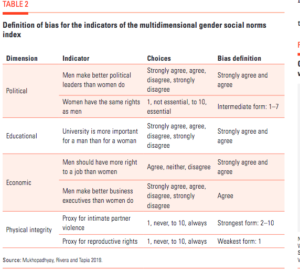“No country in the world — rich or poor — has achieved gender equality. All too often, women and girls are discriminated against in health, in education, at home and in the labour market—with negative repercussions for their freedoms”. “It would take 257 years to close the gender gap in economic opportunity. The number of female heads of government is lower today than five years ago, with only 10 women in such positions among 193 countries (down from 15 in 2014).”
In 2020, this is the conclusion of he United Nations Development Programme (UNDP). A few days before March 8th, the UNDP published its latest report: “The world is not on track to achieve gender equality by 2030. The Human Development Report’s Gender Inequality Index (GII)—a measure of women’s empowerment in health, education and economic status — shows that overall progress in gender inequality has been slowing in recent years”
This is the context for the core of this study (prepared by Pedro Conceição, Jon Hall, Yu-Chieh Hsu, Admir Jahic, Milorad Kovacevic, Tanni Mukhopadhyay, Anna Ortubia, Carolina Rivera and Heriberto Tapia): the social norms –the gender biases.- that say that women and men are attributed immovable roles according to general convention. The report’s authors believe that these norms are fundamental to understanding the dynamics of gender inequality that still persist and are expressed in the data with which this article begins.
To quantify these social norms, the authors of the report developed the Gender Social Norms Index (GSNI) in four areas: politics, educations, economy and physical integrity (gender-based violence and women’s reproductive rights). When applying the index to the countries included in the research, they found that still 91% of men and 86% of women showed at least one prejudice against gender equality. Going into detail: almost 50% of people worldwide say they consider men to be better political leaders; 40% believe men are better executives; almost 30% see it as justifiable for a man to hit a woman within a couple.
The GSNI included eight Latin American countries: Argentina, Brazil, Colombia, Chile, Ecuador, Mexico, Peru, and Uruguay. It also included the United States and Spain.
The index found that Ecuador is the country with the most prejudice against gender: 93.34% have at least one gender bias and 58.90% have two. It is followed by Colombia (91.40% one prejudice; 57.21% two); Brazil (89.5% and 52.39%); Peru (87.96% and 49.99%); Mexico (87.80%, 51.00%); Argentina (75.41% and 42.49%); Uruguay (74.60% and 36.70%), and Chile (74.40% and 42.20%).
In Spain, 50.50% of people showed at least one gender bias and 25.16% showed two. In the United States, it was 57.31% and 30.07%.
To develop the Gender Social Norms Index, scholars used data from the World Values Survey, a global network of social scientists who study people’s values, and their changes and influence in society and politics around the world. They used the answers to seven questions in this survey, in the periods 2005-2009 and 2010-2014, which were converted into seven indicators. This is how the Gender Social Norms Index succeeded in capturing “how social beliefs can obstruct gender equality along multiple dimensions.”

The experts applied the index in two groups of countries: a first group of 75 countries, “covering 81 per cent of the world’s population”, with data from 2005-2009 or 2010-2014, and a second group of 31 countries and 59 per cent of the world’s population, for which they used data from the two periods together.
Among the 75 countries in the measurement, there are the eight Latin American countries mentioned, and Spain and the United States, all of them in the 2010-2014 period.
According to this UNDP study, only 14% of women and 10% of men worldwide are free of gender bias.
Chile has been the Latin American country with the most progress in this regard.
When measuring between the 31 countries in the two periods, the index concludes that this country was the one that evolved the most in the number of men without gender bias. The United States did so in third place, Argentina in fourth, and Spain in tenth. For women without gender bias, Chile came in second, and the United States in tenth.
“The work that has been so effective in ensuring that differences in areas such as health and education are ended must now evolve to address something much more complex: the deeply rooted bias – among both men and women – against true equality. Current policies, despite their good intentions, are limited in scope,” says UNDP Administrator Achim Steiner in the press release that presented the report.
“Policies can target social norms directly,” the study continues “Changing unequal power relationships among individuals within a community or challenging deeply rooted gender roles can be achieved through education, by raising awareness or by changing incentives. Education and raising awareness are both based on providing individuals with new information and knowledge that can foster different values and behaviours. Such initiatives might include formal education, workplace training or media campaigns against gender stereotyping.”
